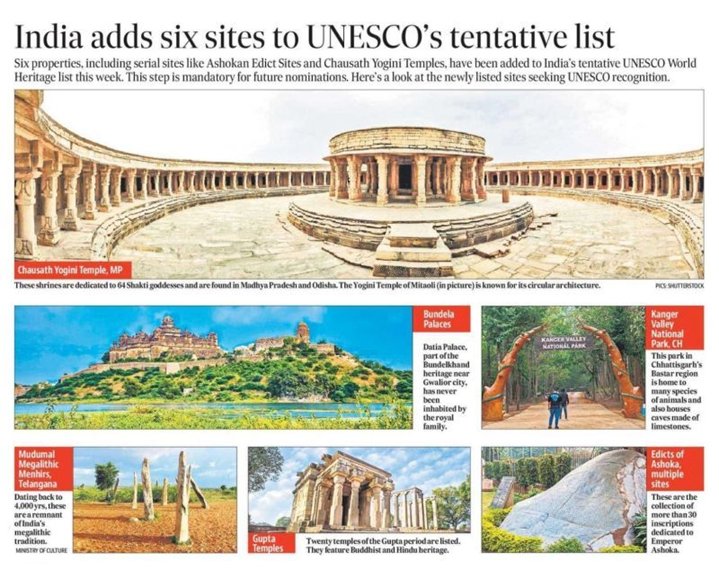MUDUMAL MEGALITHIC MENHIRS
Context :
- The Mudumal Megalithic Menhirs, or standing stones, located in the Narayanpet district of Telangana, have recently been included in the tentative list of UNESCO World Heritage Sites from India.
- These stones are believed to be between 3,500 to 4,000 years old and are significant both for their historical value and their connection to astronomy.
- In March 2025, India added 6 new properties to its UNESCO Tentative List, increasing the total count of tentative sites in the country to 62.
- This announcement was made official on March 7, through the Permanent Delegation of India to UNESCO.
WHAT IS UNESCO TENTATIVE LIST?
- The tentative list is a crucial step in the nomination process for a site to be inscribed as a UNESCO World Heritage Site.
- According to UNESCO, each country must first include a property in its tentative list before it can be formally nominated for World Heritage status.
- Being included in the tentative list is a way for countries to express their intention to recognize and protect their cultural and natural heritage for future generations.
- This inclusion reflects India’s ongoing commitment to the preservation and promotion of its vast and diverse cultural and natural heritage.
- By adding these 6 new properties to the list, India continues to expand the scope of its potential World Heritage Sites.
HISTORICAL SIGNIFICANCE
- The Mudumal Menhirs are among the largest and most well-preserved megalithic sites in India, making it an important discovery in terms of pre-historic archaeology.
- The site consists of large standing stones, arranged in specific patterns, which are believed to have served two key functions:
- Burial sites: They are likely associated with ancient burial practices, marking the graves of early communities.
- Astronomical observatories: The stones were possibly used to track celestial events like the sun and stars, suggesting a high level of astronomical knowledge.
KEY FEATURES OF THE SITE
Archaeological Importance:
- The site comprises around 80 large standing stones, each ranging from 10 to 14 feet tall, scattered over an 80-acre area.
- The stones are carefully arranged in specific alignments, which suggests they were used to mark important events such as the equinoxes and solstices, key events in the solar calendar.
- In addition to the large menhirs, there are nearly 3,000 smaller stones, adding to the site’s complexity and significance.
Astronomical Significance:
- The menhirs offer evidence of astronomical knowledge from ancient times. One of the stones is believed to represent the Ursa Major constellation (Saptarshi Mandal), which was crucial for navigation.
- Some of the stones have cup marks, which align with the North Star (Polaris), helping ancient people determine direction at night and marking the change of seasons.
Cultural Significance:
- The site is an important part of local folklore. Villagers consider the stones sacred, with one stone believed to be Goddess Yellamma. This reflects the deep spiritual connection the local community has with the site.
- The menhirs are referred to as ‘Niluralla Thimmappa’, highlighting their cultural and religious importance to the locals.
OTHER SITES ADDED TO THE TENTATIVE LIST

1. Kanger Valley National Park (Chhattisgarh)
- Location: Bastar district, Chhattisgarh
- Significance: Known for biodiversity and unique geological features.
- Key Features:
- Home to Bastar Hill Myna, the state bird of Chhattisgarh.
- Habitat for a variety of flora and fauna of national and international importance.
- Offers ecotourism potential due to its natural beauty.
2. Ashokan Edict Sites along the Mauryan Routes (Multiple States)
- Location: Various states (Madhya Pradesh, Uttar Pradesh, Bihar, Orissa, etc.)
- Significance: Serial nomination of sites with Ashoka’s edicts, dating back to the 3rd century BCE.
- Key Features:
- Reflects Mauryan governance and support for Buddhism.
- Inscribed on rocks, caves, and pillars across India.
3. Chausath Yogini Temples (Multiple States)
- Location: Madhya Pradesh, Odisha, Uttar Pradesh, Tamil Nadu
- Significance: Ancient temples dedicated to 64 Yoginis, representing Hindu Tantra and spirituality.
- Key Features:
- Built between the 9th-12th centuries.
- Roofless, circular or octagonal temples.
- Contains 64 images of Yoginis, with intricate stone carvings.
- Many temples located on hilltops with scenic views.
4. Gupta Temples of North India (Multiple States)
- Location: Uttar Pradesh, Madhya Pradesh, Rajasthan
- Significance: Early examples of temple architecture during the Gupta period (4th-6th centuries CE).
- Key Features:
- Transition from cave architecture to structural temples.
- Temples like Dashavatara Temple (Deogarh) and Bhitargaon Temple (Uttar Pradesh).
- Shikhara towers, intricate sculptures, and terracotta panels.
5. Palace-Fortresses of the Bundelas (Madhya Pradesh & Uttar Pradesh)
- Location: Orchha (Madhya Pradesh) and Datia (Uttar Pradesh)
- Significance: Architectural masterpieces of the Bundela dynasty (medieval period).
- Key Features:
- Fusion of Rajput and Mughal architectural styles.
- Jehangir Mahal (Orchha) and Govind Mahal (Datia) as key examples.
- Represents the cultural context of the Bundela dynasty.
INDIA’S CURRENT UNESCO WORLD HERITAGE SITES
- Total: 43 World Heritage Sites (2024).
- Cultural Sites: 35
- Natural Sites: 7
- Mixed Sites: 1
- Notable Addition (2024): Moidams (Ahom Dynasty burial sites) in Assam, officially inscribed on the World Heritage List.
In conclusion, the Mudumal Menhirs are a remarkable archaeological site that blends both ancient burial practices and advanced knowledge of astronomy. This recognition by UNESCO is an important step toward preserving and studying the site for future generations.
Note: Connect with Vajirao & Reddy Institute to keep yourself updated with latest UPSC Current Affairs in English.
Note: We upload Current Affairs Except Sunday.


